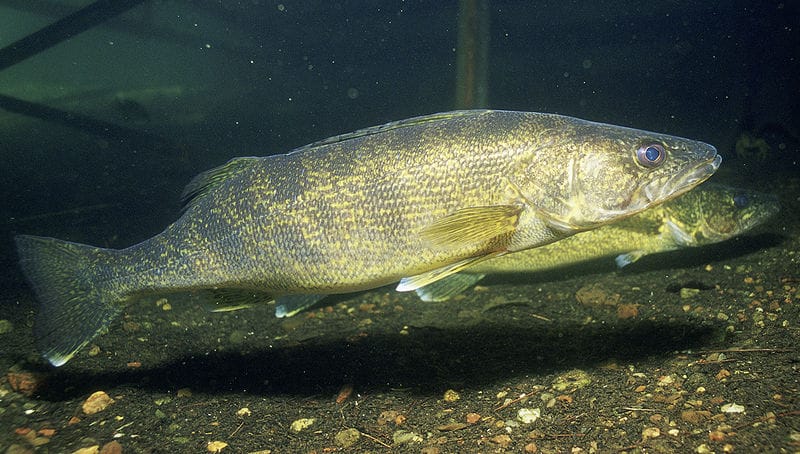
Image by Paul Rosemeyer via Flickr
[dropcap]I[/dropcap]n one of the most memorable parts from the 2017 documentary movie “Sacred Cod,’’ an angry New England fisherman taunts of a federal fisheries chief at a public meeting by calling him a paid liar. In the part of the movie leading to this climax, commercial anglers and community leaders in the old fishing harbor of Gloucester, Massachusetts, deny government reports that the cod population is near its end. The locals say their way of life has been unfairly crushed by the governments limitations on their fishing and harvesting. In this case, the Anglers are right, and the group in charge of the Cod regulations has to change in order for the citizens to be happy. Minnesota’s situation with Mille Lacs lake is almost sociologically identical to the situation in massachusetts, where distrust and public discord are intensifying over walleye protections that have made it illegal for all anglers to keep any fish during the summer season.
The DNR has done too much to mille lacs lake, causing the lake and business owners around the lake to suffer.
The problem is that the DNR is doing a lot to the lake without the public’s approval. The residents are all saying that the population has rebounded, and that the DNR is making regulations and restrictions that are hurting a lot of businesses, and not necessarily benefiting the taxpayers. According to the second DNR site i visited, the population of walleye started at over one million in 2002, and soon reached impossibly low numbers close to 250000 fish in 2014, since then the population of walleye has reached over 750000. Obviously, the walleye are rebounding well. Even though there is evidence supporting this, the DNR still are tightening restrictions on walleye keeping size. The slot this year is one 18 to 20 inch fish, and you cannot be on the lake after 10 pm. Sondra Erickson is an activist who stands up against these regulations and shows the DNR what the majority of the people were thinking. In a recent interview, she shares her opinions with the Star Tribune on how the DNR is handling negotiations with 8 Chippewa tribes around the lake. In the interview, Sondra states, “My sense is that we’re always giving in … instead of standing up for the taxpayers and those whose livelihood depends on this activity,” and later on in the same article, “The whole idea of negotiating a quota has to be re-examined.” . This comes after the public found out of a secret negotiation meeting between the DNR and those tribes, where nearly everything the Chippewa wanted was accepted and very few things the DNR wanted were accepted. Many even believe that the restrictions would be gone altogether if the DNR had stood their ground and got what they wanted from the tribes in previous meetings. Also, another huge part of the problem is just the fact that the people controlling the lake are not being clear with the public. When Senator Bill Ingebrigtsen was asked about the DNR and their honesty, he said, “I want more openness from fisheries managers and a better explanation of why the area’s walleye economy has been dimmed by a catch-and-release rule” (Star Tribune). Both his views on the clarity of the DNR and the way that Erickson thinks about the DNR and their ways of handling negotiations are widely supported by the public. These two things are what is mostly hurting Mille Lacs Lake and the entire economy surrounding it.’
There is hope for the DNR to regain the trust of the public and restore the lake though. The two main problems the public had were that the DNR was giving into the Chippewa during negotiations, and that they were not telling the public much. In an online article, A Republican House speaker named Kurt Daudt was asked how the DNR could potentially make a rebound from this so-called crisis. He said that he thinks the DNR does need to be included in special session discussion, and specifically how they’ve managed the population of walleye in the lake and whether there’s some things that need to be done differently . There is another interesting thought going around during other meetings that the state should try and get the DNR to fully control the lake, with no tribes having say on what the government says to do with the lake. The DNR estimates that in 2002, there were over million walleye in Mille lacs lake. Now, in 2014 when this conflict arose, the estimated population is only 249,000. That is over a 75% decrease in walleye population in just over a decade.
Image by Judith Doyle via Flickr
Some people believe that this is because the Indians are always able to get what they want out of any negotiations, while still keeping the right to use gill nets. Gill nets are able to put a massive dent in a fish population. A man who goes by Oslin in the article says that the co management system that the Chippewa and DNR have isn’t working and should be challenged. If these two things discussed were fixed, the situation would only get better because when you take an entire group of people out of a committee, a simpler solution can be found that does not necessarily have to appeal to another group of people, and If the DNR told the public everything the public would begin to trust them again.
There are still people who believe that the DNR is doing too little to save the lake as well. For example, people are saying that if only they would repeatedly dump more walleye fry into the lake that it will make a rebound, or if they started growing them before releasing them that they would survive longer. These facts do hold truth; if the DNR dumps more fish in, then obviously some of the fish will survive and increase population. But if we look at where this all began, we can see that the whole problem was caused by the DNR completely taking control and not letting mother nature do what she does. The DNR is taking action by dumping more fry into the lake, as specified above. The DNR says that because of a particularly good survival rate in the 2014 hatch, the population should soon be on the rise.
The DNR has been doing to much to try and conserve Mille lacs lake. This has been caused by them hiding secrets from the public and by having to cooperating with the Chippewa for a long time in order to do anything to the lake. Because of the DNR and their actions, Mille lacs lake is suffering, along with many businesses who have to deal with this restrictiction. Before long, it may be too late for the lake to make a comeback; we have to act to save the lake now. Not just for the lake , but the people who rely on the lake as well.
Featured image by: Animal Diversity Web






What do you think?
Show comments / Leave a comment